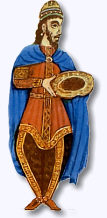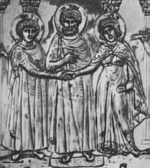Cilicia and Byzantine Armenia
Cilician Kingdom and Armenian Emperors of Byzantium
Tour Armenia
SELJUKS AND CILICIA ARMENIANS IN BYZANTIUM
The Seljuk Invasion and Cilicia
By the middle of the 11th century, Byzantium had annexed most of Armenia, though the alliance was of little help when the Bagratid Kingdom was destroyed by a new invasion of Seljuk Turks from Central Asia. With little resistance from a weakened Byzantium, the Seljuks spread throughout Asia Minor and Armenia in the 1060s and 1070s. This invasion precipitated a further division in the kingdom, and migration of large numbers of Armenians towards Christian Poland or Georgia, while others joined Armenians living beyond the Taurus Mountains in the northeast corner of the Mediterranean Sea, the Kingdom of Cilicia or Lesser Armenia.
Cilician Kings and Queens
It was a small mountainous country on the Northeast coast of the Mediterranean. It must have strongly reminded the exiles of their homeland; besides, the first Armenian settlements had already appeared in Cilicia during the rule of Tigran the Great (97-86 BCE). Towards the end of the eleventh century various regions and cities of Cilicia united into a principality under the Roubenids - a dynasty founded by former vassals of the Armenian king Gagik Bagratuni. They moved to Cilicia where they owned a castle in the Taurus mountains, near the so-called Cilician Gates (a passageway in the mountains).
A century later, under Leon II, the principality was transformed into a kingdom which lasted for almost two hundred years - up to the end of the fourteenth century - and for the whole of this time remained one of the most influential states of the Middle East. Its influence was due, to a great extent, to its geographical position: situated out of the way of the Turkish invaders, surrounded by chains of mountains interrupted only by several narrow passages, or "gates", with the sea-coast completing this natural barrier, Cilicia could enjoy relative safety and peace. On the other hand, this small country stood at the junction of Europe, Asia and Africa, where important trade routes uniting these parts of the world crossed. Lying on the route of the Crusaders, it was a kind of intermediary between Armenia and neighbouring states, since it had to maintain relations with Byzantium, the Seljuk Sultanate, the kingdom of Jerusalem, the Antioch principality of the Crusaders, the Egyptian Sultanate, the Mongols, the Pope of Rome, and the Venetian merchants.
The successful wars fought by the Armenian princes in Cilicia, their flexible diplomacy and farsighted policy ensured considerable independence to the country and its political and military power. As a result, Cilicia was a region where the expansion of trade, the growth and prosperity of cities, the development of crafts, and, finally, the flourishing of culture and the arts were for a long time unhampered by political hazards.
 Cilicia achieved a remarkable success: fortresses and feudal castles, monasteries and churches, caravanserais and baths, schools and hospitals, bridges, aqueducts and canals were built throughout the small country. Ships from many different countries called at its well-protected ports; its mountain passes served as gates for numerous caravans carrying precious Oriental goods; its cities were surrounded by several lines of fortifications throbbed with life and activity, and trade and crafts flourished. Cilicia achieved a remarkable success: fortresses and feudal castles, monasteries and churches, caravanserais and baths, schools and hospitals, bridges, aqueducts and canals were built throughout the small country. Ships from many different countries called at its well-protected ports; its mountain passes served as gates for numerous caravans carrying precious Oriental goods; its cities were surrounded by several lines of fortifications throbbed with life and activity, and trade and crafts flourished.
The city of Sis, the capital of Cilicia, was admired for its impregnable fortress and magnificent royal palace. The walls were decorated with bas-relief, lavishly adorned with mosaics, gilt and marble. The city boasted a rich library and beautiful gardens and numerous churches, schools, public baths and hospital. Monasteries, which had always played an important role in Armenian cultural and artistic life, also prospered in Cilicia. The new monastery buildings and churches were decorated with frescoes; monastic libraries and scriptoria in Cilicia, as in Armenia proper, produced illuminated manuscripts. While our knowledge of Cilician architecture, monumental painting and minor arts remains somewhat fragmentary, we have a pretty good idea of the evolution of Cilician miniature painting, which is well represented in the Matenadaran collection in Yerevan.
The art of book painting in Cilicia goes back to the eleventh-century miniature art of Armenia proper. The first Armenian settlers in Cilicia did not break links with their native land, regarding the new kingdom as a political successor to the state of Armenia.
Close contacts with Europe during the time of the Crusades, especially by Leo the Great (1187-1219, crowned by a German cardinal in 1199), led to the kingdom absorbing Western European ideas, including its feudal class structure, European dress, and the use of Latin and French along with Armenian.
For nearly 300 years, the Cilician Kingdom of Armenia prospered, but in 1375 it fell to the Mameluk dynasty of Egypt. The last monarch, King Levon VI, died at Calais, France in 1393, and his remains were laid to rest at St. Denis (near Paris) among the kings of France.
Armenia and Byzantium
 While some know the shared history betwen Armenia and Byzantium, very few (except historians and Trivial Pursuits freaks) know that for 400 years, Armenian generals, consulars and kings ruled or helped rule Byzantium during its most evocative period. Certain historians (British mostly) decry this period as a desecration or period of decay, but in fact, beginning with the Armenian period, Byzantium successufully navigated survical and growth in the midst of Cursades and Seljuk-Turk expansion. While some know the shared history betwen Armenia and Byzantium, very few (except historians and Trivial Pursuits freaks) know that for 400 years, Armenian generals, consulars and kings ruled or helped rule Byzantium during its most evocative period. Certain historians (British mostly) decry this period as a desecration or period of decay, but in fact, beginning with the Armenian period, Byzantium successufully navigated survical and growth in the midst of Cursades and Seljuk-Turk expansion.
The Byzantine historian Procopius mentions sixteen Armenian generals in Justinian's army, in addition to the famous general Narses. An even larger number held top positions during the 8th-11th centuries, and Byzantium owed its victorious campaigns against the Arabs primarily to the skill of such Armenian generals as Petronas, the brother of the empress Theodora, and John Curcuas (Gurgen). The chief naval commander during the reign of Romanus Lecapenus was Alexius Musele, an Armenian.
Armenians appear as governors of provinces, and more than one ascended the imperial throne. This is perhaps most surprising of all--after all, most of us assume Byzantine's rulers were all, well, East Roman, or at least of a 'Byzantium ethnic build'. Not so.
Beginning with Heraclius, and for several centuries thereafter, most of the emperors were Armenian. The so-called Macedonian dynasty was an Armenian dynasty, since Basil I, though born in Macedonia, was an Armenian. During the 12th century even the usurpers--Romanus Lecapenus, Nicephorus Phocas, John Tzimisces--were wholly or partly Armenian. Almost every major figure in the administration of the 9th-10th centuries was Armenian, so much so that some historians refer to the centuries as the Greco-Armenian period. During the 11th century several Armenian families continued to hold prominent positions in Byzantium.
The Caesar Bardas, brother of the Empress Theodora, whose decade of administration (856-866) has been considered one of the most brilliant in Byzantine history, re-established the University of Constantinople, housed in the palace of the Magnaura, laying the foundations for the revival that took place in the 9th-10th centuries. He entrusted the direction of the university to another Armenian, Leo the Philosopher or the Mathemetician, a man of encyclopedic knowledge. Leo's uncle, John the Grammarian, the iconoclast patriarch from 837-843, was another Armenian reputed for his erudition.
And so on, so much we begin to think Armenians formed the basis of most empires. Not at all true, but this does illustrate how so called conquered people can thrive in many circumstances.
Back to the story.


 Top
Top

|
